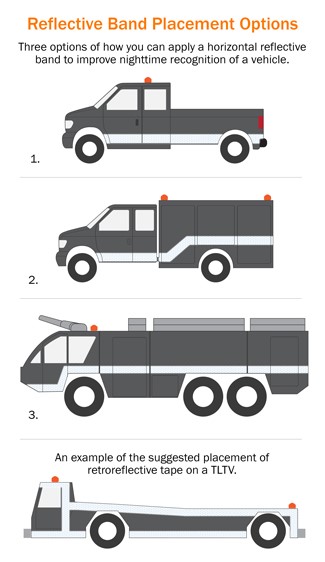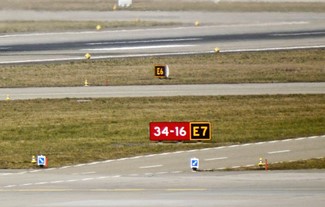Best Practices for Airfield Vehicle Marking

The demand for air travel is on the rise which means more personnel navigating the airfield, increasing the chances for human error. Runway safety is a significant challenge and a top priority for all in the aviation industry. No one wants their airport making headlines due to a crash or a close call on the runway.
In the past four years, airport marking was listed among the top three discrepancies recorded during airport inspections. The lack of maintenance to signs, lights, markings, and construction project installation errors were the most common occurrences during these inspections.
Proper maintenance of all markings on the airfield is included in the certification and operations of airports (14 CFR Part 139) required by the Federal Aviation Association (FAA). The FAA also produces Advisory Circulars (ACs) that serve as informational guides to help assist all personnel in the industry with compliance and best practices for operations.
Reduce danger and improve clarity and awareness on the airfield with a breakdown of requirements and tips for proper airfield vehicle marking.
Safety Starts and Ends with Communication
The number one safety challenge in the aviation industry is runway incursions. An average of three runway incursions occur daily in the U.S. with approximately 65% caused by pilots (>FAA.
Airfield design is one of the main contributing factors of runway incursions. Drivers must always have a current airport diagram in their vehicle and get as familiar as possible with the airport's roads, taxiways, and runways before driving alone on the airfield. Drivers must get authorization from air traffic control (ATC) to enter any part of the airport movement area, as well as be in two-way radio communication to receive directions. In non-towered airports, drivers do not need permission before they enter a runway or taxiway. When in doubt, drivers should stop and ask for help or clarification from ATC.
Compliant airfield vehicle marking is crucial for safe daily operations on the airfield. Proper vehicle marking helps pilots, staff, and ATC clearly identify vehicles to prevent runway incursions.
Vehicle Marking Requirements

A report by the National Highway Safety Administration (NHTSA) states that reflective tape can effectively reduce the impact into trailers by 29%. This report led to the Federal Carrier Safety Administration (FMCSA) to require large commercial vehicles to be marked with retroreflective sheeting and conspicuity systems. This requirement also stands true to airfield vehicles.
Most Common Types of Airfield Vehicles:
- Emergency Vehicles: ambulances and aircraft rescue and firefighting (ARFF) vehicles for emergency duties
- Airport Operations Vehicles: provide airport inspections and operational duties on the airfield
- Airfield Service and Support Vehicles: conduct maintenance, service, construction, and support operations
- Towbarless Towing Vehicle (TLTV): tows the aircraft
- Airport Security: operates as needed for security purposes (e.g.: police cars)
- Other Vehicles: includes vehicles that do not usually operate on any part of the airport operations area (AOA). These vehicles must be escorted by vehicles who have two-way radio communication with ATC and are authorized to drive on the AOA
The FAA declares airport vehicle and paint markings as a safety of flight requirement and encourages airport operators to follow AC 150/5210-5D Painting, Marking, and Lighting of Vehicles Use on an Airport for best practices.
All authorized vehicles that regularly operate on the movement and safety areas of the AOA must:
- Be painted and marked with conspicuous and contrasting colors
- Display identification numbers or a company logo
- Have a flashing yellow beacon
- Be marked or flagged for high daytime visibility and nighttime operations if appropriate
- Airports that do not have air traffic control facilities must provide flags for all vehicles. The flag must be at least a 3-foot by 3-foot square with a checkered pattern with international orange and white squares at least 1 foot on each side
- Vehicles that need intermittent identification can be marked with magnetically attached identification markers
Airport Markings and Signs
It's important all drivers understand the meaning of signs and markings used on airports to serve as navigational aids. There are main categories of sign types used on airfields that drivers must know:

- Mandatory Instruction Signs: indicates taxiway/runway intersections, runway approach areas, Instrumental Landing System (ILS) critical areas, military landing zones, no entry areas, and more. These signs have white text outlined in black on a red background.
- Locations Signs: identifies the taxiway or runway the aircraft is on. These signs have yellow text on a black background with a yellow border that must be set in from the inner edge of the sign.
- Boundary Signs: identifies the location of the Runway Safety Area (RSA)/Obstacle Free Zone (OFZ) for a pilot exiting the runway. The sign has black text on a yellow background.
- Direction Signs: indicates directions of taxiways that lead out of an intersection. It can also be used to specify a taxiway exit from the runway. These signs have black text on a yellow background that always contain arrows.
- Taxiway Ending Marker: communicates that a taxiway no longer continues beyond an intersection. This sign has alternating diagonal black and yellow stripes.
- Destination Signs: communicates the general direction to a remote location. The sign has black text on a yellow background and always contains an arrow.
- Information Signs: installed on the airside of an airport to communicate information other than mandatory holding positions, runway distance remaining signs, and taxiway guidance. These signs have black text on a yellow background.
- Vehicle Roadway Signs: located on the airfield and are intended for vehicle operators. (e.g.: STOP and YIELD signs).
- Runway Distance Remaining Signs: communicates information to pilots during takeoff and landing operations about distance remaining information. The sign has a white numeral inscription on a black background.
Implement Compliance Solutions
The increase in demand for quick aircraft turnaround puts added time pressure from pilots and ATC on ground personnel-this makes effective training and compliant visual marking and communication a time-and life-saver.
Anyone in the aviation industry or any organization with a large number of cars or trucks can identify fleet vehicles using PathFinder reflective tapes by Duralabel. These tapes increase visibility day and night and can be applied to a variety of surfaces and industrial applications. All PathFinder high-intensity reflective tape either exceed DOT compliance and/or ASTM D 4956 Type III and Type IV requirements for retroreflective sheeting.
Use reflective stick-ons to add reflection wherever needed-these DOT-certified shapes let you simply peel and stick to nearly any application including semi-truck fenders, personal protective gear like hard hats, and other general outdoor equipment and smaller items used in low-light situations. Ensure dependable visibility with our conspicuity red and white reflective tape with a life of five to 10 years, ideal for use on trucks, trailers, buses, and rail cars to increase visibility for drivers, ATC, and pilots from afar.
For general facility safety signs and labels that need to stand out in low-light conditions, use DuraLabel Reflective Vinyl Tape supply-compatible with nearly any DuraLabel industrial label printer. The supply is constructed from engineering-grade reflective vinyl with durable adhesive for a strong bond for labels and signs that last indoors and out.
Other applications:
- Print airfield roadway signs
- Create a variety of emergency, wayfinding, and general facility signs and labels
- Print reflective floor marking messages and graphics
- Outline construction zone devices like barrels or cones
Be proactive to reduce dangers by maintaining proper airport sign and airfield vehicle marking.
Related Resources

Overcome Aviation Safety Top Challenges: Runway Safety and Incursions with the FAA
What Is the FAA Doing to Improve Runway Safety? The Federal Aviation Administration (FAA) is strengthening ...
Read
Airfield Safety Hinges on Communication
Safety is a top priority for all in the aviation industry, however, there is no shortage of challenges. Part ...
Read
5S Floor Marking: Organization & Safety Fundamentals for Your Facility
What is 5S floor marking? 5S floor marking helps communicate workplace organization, improve safety, and ...
Read.png)





